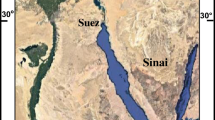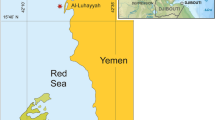Abstract
The actual and fatal concentrations of selected heavy metals, including cadmium, cobalt, copper, lead, nickel, and zinc in corals from the Gulf of Aqaba were determined. Several living coral samples of different species (e.g., Porites) were collected from shallow depths (of about 5 m) at a number of sites along the Jordanian Gulf of Aqaba coast. The coral samples were collected using either a pneumatic diamond drill corer (for Porites) or a hammer and chisel (for other branched species). Some of the corals that had been collected were analyzed for heavy metals using atomic absorption spectrometry, and other samples were used in incubation experiments. The heavy metal concentrations were determined separately in the coral skeleton and the tissue layer. Heavy metal concentrations have not previously been determined in corals from the Gulf of Aqaba. We conclude that corals are suitable for use as proxy tools for assessing environmental pollution (i.e., they are bioindicators) in the Gulf of Aqaba and the Red Sea. Therefore, this study provides useful information on the degree of heavy metal contamination in the study area.





Similar content being viewed by others
References
Adriano, D. C. (1986). Trace elements in terrestrial environments. New York: Springer-Verlag.
Akpan, E. R., Ekpe, U. J., & Ibok, U. J. (2002). Heavy metal trends in the Calabar River, Nigeria. Environmental Geology, 42(1), 47–51.
Alloway, B. J. (1990). Heavy metals in soils. Glasgow: Blackie.
Bastidas, C., & Garcia, E. (1997). Metal concentration in the tissue and skeleton of the coral Montastrea annularis at a Venezuelan reef. In H. A. Lessios & I. G. Macintyre (Eds.), Proceedings of the 8 th International Coral Reef Symposium (Vol. 2, pp. 1847–1850). Panama: Smithsonian Tropical Research Institute.
Bastidas, C., & Garcia, E. (1999). Metal content on the reef coral Porites astreoides: an evaluation of river influence and 35 years of chronology. Marine Pollution Bulletin, 38(10), 899–907.
David, C. P. (2003). Heavy metal concentrations in growth bands of corals: a record of mine tailings input through time (Marinduque Island, Philippines). Marine Pollution Bulletin, 46(2), 187–196.
Denton, G. R., & Burdon-Jones, C. (1986). Trace metals in corals from the Great Barrier Reef. Marine Pollution Bulletin, 17(5), 209–213.
Esslemont, G. (1997). Heavy metals in scleractinian corals and marine sediments from Heron Island and Darwin Harbour, Australia. In J. R. Hanley, G. Caswell, D. Megirian, & H. K. Larson (Eds.), Proceedings of the Sixth International Marine Biological Workshop. The marine flora and fauna of Darwin Harbour, Northern Territory, Australia. Darwin, Australia: Museums and Art Galleries of the Northern Territory.
Esslemont, G. (1999). Heavy metals in corals from Heron Island and Darwin Harbour, Australia. Marine Pollution Bulletin, 38(11), 1051–1054.
Esslemont, G. (2000). Heavy metals in seawater, marine sediments and corals from the Townsville section, Great Barrier Reef Marine Park, Queensland. Marine Chemistry, 71, 215–231.
Förstner, U. (1989). Contaminated sediments. Lectures on environmental aspects of particle-associated chemicals in aquatic systems. Heidelberg: Springer-Verlag.
Glynn, P. W., Szmant, A. M., Corcoran, E. F., & Cofer-Shabisa, S. V. (1989). Condition of coral reef cnidarians from the northern Florida reef tract: pesticides, heavy metals, and histopathological examination. Marine Pollution Bulletin, 20(11), 568–576.
Guzmán, H. M., & Jiménez, C. E. (1992). Contamination of coral reefs by heavy metals along the Caribbean coast of Central America (Costa Rica and Panama). Marine Pollution Bulletin, 24(11), 554–561.
Hanna, R. G., & Muir, G. L. (1990). Red Sea corals as biomonitors of trace metal pollution. Environmental Monitoring and Assessment, 14(2–3), 211–222.
Harland, A. D., & Brown, B. E. (1989). Metal tolerance in the scleractinian coral Porites lutea. Marine Pollution Bulletin, 20(7), 353–357.
Howard, L. S., & Brown, B. E. (1986). Metals in tissues and skeletons of Fungia fungites from Phuket, Thailand. Marine Pollution Bulletin, 17(12), 569–570.
Howard, L. S., & Brown, B. E. (1987). Metals in Pocillopora damicornis exposed to tin smelter effluent. Marine Pollution Bulletin, 18(8), 451–454.
Luoma, S. N. (1983). Bioavailability of trace metals to aquatic organisms — A review. Science of the Total Environment, 28(1–3), 1–22.
Luoma, S. N. (1990). Processes affecting metal concentration and coastal marine sediments. In R. W. Furness & P. S. Rainbow (Eds.), Heavy metals in the marine environment (pp. 51–66). Boca Raton: CRC Press.
Marine Science Station Internal Reports. (1996). Aqaba, Jordan: Marine Science Station.
McConchie, D., & Harriott, V. J. (1993). The partitioning of metals between tissue and skeletal parts of corals: application in pollution monitoring. In R. H. Richmond (Ed.), Proceedings of the 7th International Coral Reef Symposium (Vol. 1, pp. 97–103). Guam: University of Guam Press.
Nair, C. K., & Balchand, A. N. (1993). Speciation of trace metals in sediments of tropical estuary. Environmental Geology, 21(1–2), 96–102.
Nriagu, J. O. (1988). A silent epidemic of environmental metal poisoning? Environmental Pollution, 50(1–2), 139–155.
Nriagu, J. O. (1996). A history of global metal pollution. Science, 272(5259), 223.
Otchere, F. A. (2003). Heavy metals concentrations and burden in the bivalves (Anadara (Senilia) senilis, Crassostrea tulipa and Perna perna) from lagoons in Ghana: model to describe mechanism of accumulation/excretion. African Journal of Biotechnology, 2(9), 280–287.
Phillips, D. J. H. (1990). Use of macroalgae and invertebrates as monitors of metal levels in estuaries and coastal waters. In R. W. Furness & P. S. Rainbow (Eds.), Heavy metals in the marine environment (pp. 81–99). Boca Raton: CRC Press.
Rainbow, P. S. (1995). Biomonitoring of heavy metal availability in the marine environment. Marine Pollution Bulletin, 31(4–12), 183–192.
Reichlet-Brushett, A. J., & McOrist, G. (2003). Trace metals in the living and nonliving components of scleractinian corals. Marine Pollution Bulletin, 46(12), 1573–1582.
St. John, B. E. (1974). Heavy metal in the skeletal carbonate of scleractinian corals. In A. M. Cameron, B. M. Cambell, A. B. Cribb, R. Endean, J. S. Jell, O. A. Jones, P. Mather, & F. H. Talbot (Eds.), Proceedings of the Second International Coral Reef Symposium (Vol. 2). Brisbane: The Great Barrier Reef Committee.
Scott, P. J. B. (1990). Chronic pollution recorded in coral skeletons in Hong Kong. Journal of Experimental Marine Biology and Ecology, 139(1–2), 51–64.
Scott, P. J., & Davies, M. (1997). Retroactive determination of industrial contaminants in tropical marine communities. Marine Pollution Bulletin, 34(11), 975–980.
Singh, M. (2001). Heavy metal pollution in freshly deposited sediments of the Yamuna River (the Ganges River tributary): a case study from Delhi and Agra urban centres, India. Environmental Geology, 40(6), 664–671.
Acknowledgments
This work was financed by the Deanship of Scientific Research, Jordan University of Science and Technology and the Marine Station in Aqaba, Jordan.
Author information
Authors and Affiliations
Corresponding author
Rights and permissions
About this article
Cite this article
Barakat, S.A., Al-Rousan, S. & Al-Trabeen, M.S. Use of scleractinian corals to indicate marine pollution in the northern Gulf of Aqaba, Jordan. Environ Monit Assess 187, 42 (2015). https://doi.org/10.1007/s10661-015-4275-2
Received:
Accepted:
Published:
DOI: https://doi.org/10.1007/s10661-015-4275-2




